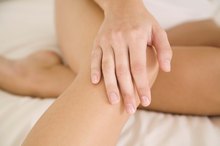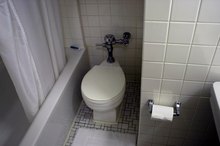What does fact checked mean?
At Healthfully, we strive to deliver objective content that is accurate and up-to-date. Our team periodically reviews articles in order to ensure content quality. The sources cited below consist of evidence from peer-reviewed journals, prominent medical organizations, academic associations, and government data.
The information contained on this site is for informational purposes only, and should not be used as a substitute for the advice of a professional health care provider. Please check with the appropriate physician regarding health questions and concerns. Although we strive to deliver accurate and up-to-date information, no guarantee to that effect is made.
Is Calcium Good for Gout?
A vast majority of the time, calcium is good for your body and is essential in building and maintaining healthy bones and joints.
If you are experiencing serious medical symptoms, seek emergency treatment immediately.
However, calcium can cause a great deal of pain in some individuals. This condition is known as pseudogout, which mimics the symptoms of gout. According to MayoClinic.com, calcium is not one of the treatment methods or pain relief methods for individuals suffering from gout.
Pseudogout
Pseudogout is an arthritis condition that causes sudden and painful swelling in one or multiple joints in your body.
Those with pseudogout may also experience warmth at the joints. Symptoms may flare up for days or weeks, according to MayoClinic.com. This condition commonly occurs in the knees and in older adults.
Pseudogout occurs when calcium crystals form in the fluid that lines your joints. Pseudogout is also known as calcium pyrophoshate deposition.
- Pseudogout is an arthritis condition that causes sudden and painful swelling in one or multiple joints in your body.
- Pseudogout occurs when calcium crystals form in the fluid that lines your joints.
Pseudogout Treatment
How Can I Get Rid of a Bone Spur on My Knee?
Learn More
While it is unclear why calcium crystals form in your joints, these crystals cannot be removed or eliminated.
However, there are ways to treat the pain and reduce inflammation when you experience flare-ups of pseudogout. Your doctor may recommend anti-inflammatory medications such as colchicine -- which is another medication that reduces inflammation.
Your doctor may also recommend injections to relieve inflammation or joint aspiration to remove some of the fluid in your joints. Activity modification and rest are also recommended when you experience a pseudogout flare-up.
- While it is unclear why calcium crystals form in your joints, these crystals cannot be removed or eliminated.
- Your doctor may recommend anti-inflammatory medications such as colchicine -- which is another medication that reduces inflammation.
Gout
Gout is a complex arthritis that causes sudden and severe attacks. Symptoms include pain, redness and tenderness of the joints. MayoClinic.com indicates gout often occurs at the base of your large toe.
Gout occurs when urate crystals form in your joints -- urate crystals occur as the result of high levels of uric acid in your bloodstream. Uric acid helps to break down purines -- substances found in foods such as asparagus and mushrooms. When uric acid builds up in your body, crystals form in joints and tissues, causing gout.
- Gout is a complex arthritis that causes sudden and severe attacks.
- Gout occurs when urate crystals form in your joints -- urate crystals occur as the result of high levels of uric acid in your bloodstream.
Gout Treatment
Gout and Shrimp
Learn More
Gout cannot be cured, but it can be treated, although it is not possible to know when you are going to experience a gout flare-up. Your doctor may recommend that you use non-steroidal anti-inflammatory medications to control pain and inflammation. Anti-inflammatory medications can also help to prevent further attacks of gout when taken regularly. Corticosteroid injections may be given to control pain and inflammation. Your doctor may also prescribe medications to help regulate uric acid in your bloodstream.
- Gout cannot be cured, but it can be treated, although it is not possible to know when you are going to experience a gout flare-up.
- Your doctor may also prescribe medications to help regulate uric acid in your bloodstream.
Calcium
While calcium cannot help to control or prevent flare-ups of gout or pseudogout, you should consume calcium based on dietary guidelines. Too much calcium can cause the formation of crystals, while too little calcium can cause osteoporosis and increased instances of fractures. The National Institutes of Health recommends 1,200 mg of calcium daily for adults over the age of 71 1. Females between the ages of 51 and 70 should consume 1,200 mg while men should consume 1,000 mg.
Adults ages 19 to 50 should consume 1,000 mg of calcium daily. Children ages 9 to 18 should consume 1,300 mg. Children ages 4 to 8 should consume 1,000 mg daily.
Children ages 1 to 3 should consume 700 mg. Children in the first seven to 12 months of life should intake 260 mg on a daily basis. Those up to 6 months old should receive 200 mg.
- While calcium cannot help to control or prevent flare-ups of gout or pseudogout, you should consume calcium based on dietary guidelines.
- Children ages 4 to 8 should consume 1,000 mg daily.
Related Articles
References
- National Institutes of Health; Calcium
- Cleveland Clinic. Calcium Pyrophosphate Dihydrate Deposition Disease (CPPD, or Pseudogout). December 28, 2017.
- The Department of Health and Human Services Montana. Health and Safety Guidelines Gout and Pseudogout. Published 2015.
- American College of Rheumatology. Calcium Pyrophosphate Deposition (CPPD). Last updated March 2017.
- Macmullan P, Mccarthy G. Treatment and management of pseudogout: insights for the clinician. Ther Adv Musculoskelet Dis. 2012;4(2):121-31. doi:10.1177/1759720X11432559
- Cleveland Clinic. Gout and Calcium Pyrophosphate Deposition Disease. Published June 2016.
- Rosenthal AK, Ryan LM. Calcium Pyrophosphate Deposition Disease. N Engl J Med. 2016;374(26):2575-84. doi:10.1056/NEJMra1511117
- American Society for Surgery of the Hand. Gout and Pseudogout. http://www.assh.org/handcare/hand-arm-conditions/Gout-and-Pseudogout.
- Arthritis Foundation. Calcium Pyrophosphate Dihydrate Crystal Deposition Disease (CPPD). http://www.arthritis.org/about-arthritis/types/calcium-pyrophosphate-deposition-disease-cppd/.
- Barre L. Calcium Pyrophosphate Deposition. (CPPD). American College of Rheumatology. https://www.rheumatology.org/I-Am-A/Patient-Caregiver/Diseases-Conditions/Calcium-Pyrophosphate-Deposition-CPPD.
Writer Bio
Michelle Zehr started writing professionally in 2009. She has written on health, fitness, fashion, interior design, home decorating,sports and finance for several websites. Zehr possesses a Bachelor of Arts in communication from the University of Pittsburgh, a Master of Arts in professional writing from Chatham University and a graduate certificate in health promotion from California University of Pennsylvania.









